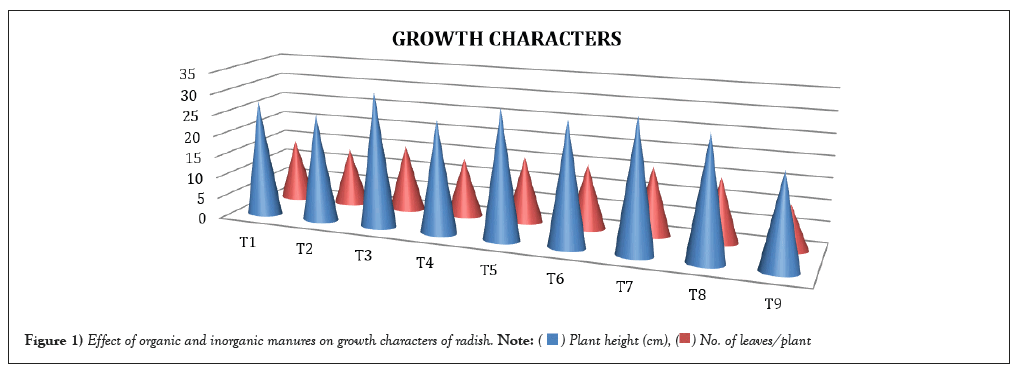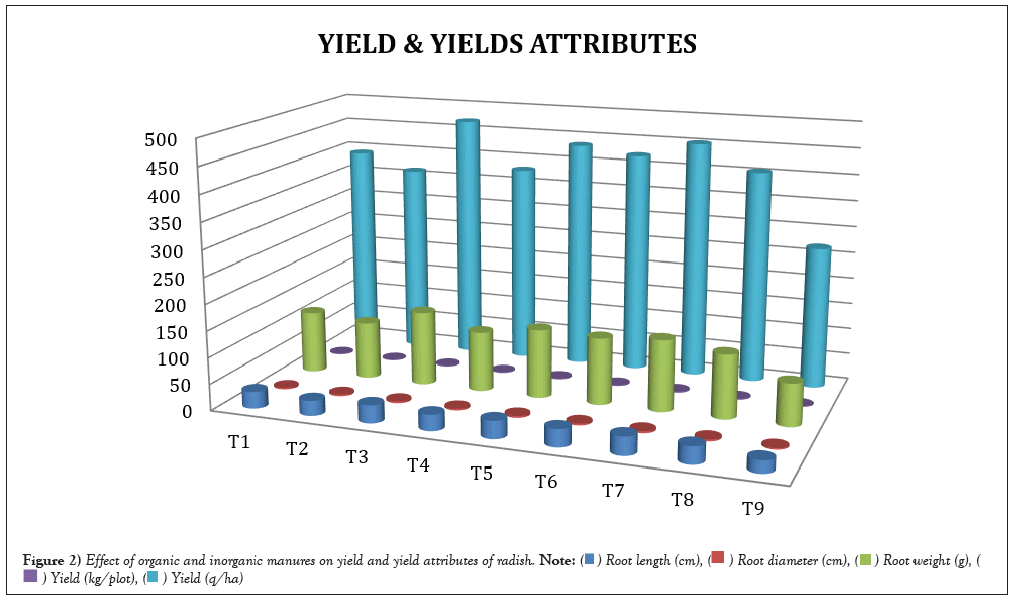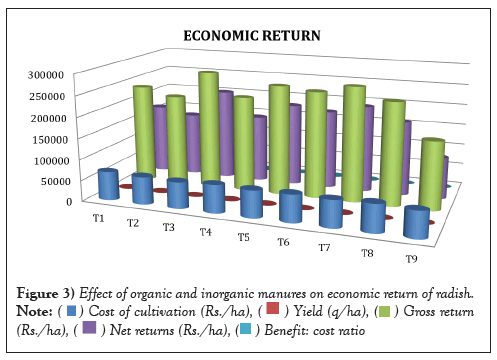Agricultural and Biological Research
RNI # 24/103/2012-R1
Research Article - (2024) Volume 40, Issue 6
The "Effect of organic and inorganic manures on growth, yield, and economic return of radish (Raphanus Sativus L.)" was the subject of a field experiment conducted during the Rabi season in 2019-20 at the research farm of Udai Pratap (Autonomous) College, Varanasi (U.P.), India, which is adjacent to the Department of Horticulture. A Randomized Block Design (RBD) was used to set up the experiment, and the nine treatments-T1:100% NPK through Vermicompost, T2:100% NPK through FYM, T3:100% NPK through Poultry manure, T4:50% NPK through Vermicompost+50%NPK through FYM, T5:50% NPK through Vermicompost+50%NPK through Poultry manure, T6:50% NPK through Poultry Manure+50% NPK through FYM, T7:75% NPK through Poultry Manure+25% NPK through Vermicompost, T8:75% NPK through Vermicompost 25% NPK through FYM, and Control (zero application) on vegetable crops comprised of 9 treatments. A 30 cm × 10 cm spacing was used for transplanting the Kashi Shweta cultivar of radish. The application of 100% NPK through poultry manure considerably boosted the growth, yield, and economic return of radish, according to the experiment's results. Consequently, it can be advised to combine organic and inorganic manures in order to take advantage of radish's higher environmentally friendly economic output.
Farm yard manure; Vermicompost; Poultry manure; Growth; Fruit yield; Organic
The Brassicaceae family includes the radish (Raphanus sativus L.). This crop of root vegetables is well-liked. The species sativus of the genus Raphanus includes the radish. Asia and Europe are its original home. It is a popular crop in both tropical and temperate countries, primarily grown during the chilly season. In India, radish was grown on 208 thousand hectares in 2019-20, yielding 3218 thousand metric tons of produce annually [1]. In India, it is mostly grown in West Bengal, Bihar, Uttar Pradesh, Maharashtra, Punjab, Assam, Haryana, Gujarat, and Himachal Pradesh. The tender young root of the radish plant, which can be eaten raw or cooked, is why it is grown. It is an excellent source of calcium, potassium, and phosphorus as well as vitamin C. It has diuretic and invigorating qualities.
Additionally, it is used to treat persistent diarrhea, insomnia, and neurological headaches. Additionally, the roots help with piles and bladder issues. Radish leaves are a good source for commercial protein extraction, and radish seeds can provide a non-drying fatty oil that can be used for edible and illuminating soap making [2]. Sustainable farming requires the development of high-quality radish and optimal nutrition from both organic and inorganic sources. Recycling crop residues, animal dung, farm organic wastes, and other residues is essential to organic agriculture techniques. The production system from which organic agriculture is formed mostly or entirely avoids the use of artificially created pesticides, fertilizers, growth regulators, preservatives, and additives for livestock feed. Therefore, recycling of crop residues, animal dung, and off-farm organic wastes and residues is essential to organic agriculture techniques. Important macronutrients (N, P2O5, K2O, Ca, and Mg) and micronutrients (Fe, Mn, Zn, and Cu) are provided by vermicompost. Vermicompost's chemical examination shows that its N, P2O5, and K2O contents were, respectively, 0.8, 1.1, and 0.5 [3]. Applying vermicompost either by itself or in combination with chicken manure greatly enhanced radish growth metrics, yield, and yield characteristics [2]. Organic materials such as FYM, vermicompost, and chicken manures have the potential to significantly enhance crop nutrition levels by directly adding nutrients, enhancing soil quality, fixing nitrogen, and solubilizing fixed forms of zinc and phosphorus in the soil.
The field experiment was carried out on the research plot next to the department of horticulture at Udai Pratap (Autonomous) College in Varanasi, Uttar Pradesh, during the 2019-20 rabi season. Illite, quartz, and feldspar predominate in the Varanasi soils, which are deposited by the Ganga river and developed on alluvial deposits. The micas that predominate in the sand and silt fractions are partially the source of illite minerals. For the experiment, a popular radish variety among farmers, Kashi Shweta, was employed. The plants were planted in a 0.45 m² plot with a spacing of 30 cm × 10 cm between each plant. T1:100% NPK through Vermicompst, T2:100% NPK through FYM, T3:100% NPK through Poultry Manure, T4:50% NPK through Vermicompost+50% NPK through FYM, T5:50% NPK through Vermicompost+50%NPK through poultry manure, T6:50% NPK through Poultry Manure+50% NPK through FYM, and T7:75% NPK through Poultry Manure+25% NPK through Vermicompost were the nine treatments that were replicated three times in the experiment. T8:Vermicompost provides 75% of the NPK. 25% NPK using FYM and Control (using nothing at all) on vegetable crops. The specifics of the treatments and their combinations are shown in Table 1. Varanasi is located in eastern Uttar Pradesh, India, and has a subtropical climate. In this area, precipitation typically falls between the final week of June and the second week of October, a span of three to four months. November through February is typically a dry and chilly month. The third week of March to June marks the start of the hot and dry summer season. The average annual precipitation is 998 mm, with 80% of that falling between June and September, 5.7% between October and December, 3.3% between January and February, and 3.0% between March and May. During the crop time, specific climatic conditions were documented, including maximum and minimum temperatures, relative humidity, rainfall distribution on a weekly basis, and sunshine hours.
| Sl. No. | Symbol | Treatments details |
|---|---|---|
| 1 | T1 | 100% NPK through vermicompost |
| 2 | T2 | 100% NPK through FYM |
| 3 | T3 | 100% NPK through poultry manure |
| 4 | T4 | 50% NPK through vermicompost+50% NPK through FYM |
| 5 | T5 | 50% NPK through vermicompost+50% NPK through poultry manure |
| 6 | T6 | 50% NPK through poultry manure+50% NPK through FYM |
| 7 | T7 | 75% NPK through poultry manure+25% NPK through vermicompost |
| 8 | T8 | 75% NPK through vermicompost+25% NPK through FYM |
| 9 | T9 | Control |
Table 1: Details of treatment and their combinations.
Growth attributes
Examining Table 2 and Figures 1 and 2 makes it clear that the current study shows that various mixes of organic manure, such as FYM, vermicompost, and poultry manure, have varying positive effects on growth parameters including plant height and leaf count per plant. When compared to the control, the majority of treatments were generally successful in considerably accelerating plant development at all stages. After planting in each treatment, there was a noticeable rise in plant height. In various treatments, the plant height at harvest varied from 21.89 cm to 31.63 cm. Regarding the impacts of the treatments, T3 (100% NPK through poultry manure) and T7 (75% NPK through poultry manure+25% from vermicompost) were the two combinations of organic fertilizers that worked best in significantly increasing plant height at every stage of observation. When it came to the quantity of leaves, the application of organic manure demonstrated that the treatments were significant at every growth stage. T7 (75% NPK via poultry manure+25% NPK via vermicompost), or 16.20 days, displayed the highest number of leaves, while T3 (15.80 days) came next. T9 (control) had the fewest leaves per plant, with an average of 10-20 days. The results are consistent with those of Uddin et al., [4], Yanthan et al., [5], and Sandeep et al., [2]. This may result from the addition of vermicompost and poultry manure, which enhances soil biomass and promotes enzymatic and hormonal activity as well as improved production of growth substances like N, P, and K. The use of poultry manure and vermicompost may have contributed to the faster development of vegetative growth and the storage of enough stored food supplies for improved growth (Figure 1).
| Treatments | Plant height (cm) | No. of leaves/ plant. | Root length (cm) | Root diameter (cm) | Root weight (g) | Yield (kg/plot) | Yield (q/ha) |
|---|---|---|---|---|---|---|---|
| T1 | 27.300 | 14.400 | 31.967 | 3.300 | 118.000 | 1.77 | 393 |
| T2 | 25.500 | 13.667 | 28.667 | 3.233 | 108.89 | 1.63 | 363 |
| T3 | 31.633 | 15.800 | 34.233 | 3.733 | 141.11 | 2.12 | 470 |
| T4 | 26.400 | 13.767 | 30.600 | 3.333 | 114.00 | 1.71 | 380 |
| T5 | 30.167 | 15.500 | 33.800 | 3.600 | 130.89 | 1.96 | 436 |
| T6 | 28.800 | 15.233 | 33.267 | 3.533 | 126.89 | 1.90 | 423 |
| T7 | 30.700 | 16.200 | 34.800 | 3.700 | 136.00 | 2.04 | 453 |
| T8 | 28.500 | 14.900 | 32.500 | 3.400 | 121.78 | 1.83 | 406 |
| T9 | 21.867 | 10.200 | 23.400 | 2.667 | 81.33 | 1.22 | 270 |
| S.Em + | 0.3384 | 0.2755 | 0.8043 | 0.0264 | 0.1613 | 0.0024 | 0.2887 |
| CD (P=0.05) | 1.0146 | 0.8260 | 2.4114 | 0.0790 | 0.4835 | 0.0073 | 0.8654 |
Table 2: Effect of organic and inorganic manures on growth and yield of radish (Raphanus sativus L.).

Figure 1: Effect of organic and inorganic manures on growth characters of radish. 

Figure 2: Effect of organic and inorganic manures on yield and yield attributes of radish. 

Yield and yield attributes
An examination of these documents shows that the current study clearly shows that various mixes of organic manure, such as FYM, Vermicompost and Poultry manure, have varying positive effects on yield and yield attributes, such as yield parameters, root length, root diameter, root weight, root yield (kg/plot), and root yield (q/ha) of radish, which increased significantly by all treatments. 34.80 cm was the highest root length measured at harvest in treatment T7 (75% NPK via poultry manure+25% NPK via vermicompost). The treatment T3 (141.11 g) with 100% NPK through poultry manure had the largest root weight. T7 (75% NPK through poultry manure+25% through vermicompost) and T5 (50% NPK through vermicompost+50% through poultry manure) came in second and third, respectively. The control group receiving therapy T9 (81.33) had the lowest root weight. The findings of Chezhiyan et al., [6] and Zhou et al., [7] are in strong agreement with these findings. The treatment T3 with 100% NPK through poultry manure had the largest root diameter (3.773 cm), while the treatment T3 with 50% NPK with poultry manure had the lowest root diameter. The control group receiving treatment T9 (2.667 cm) had the lowest root weight. The treatment T3 (470) with 100% NPK through poultry manure and T7 (75% NPK through poultry manure+25% through vermicompost) had the highest root output (q/ha). T5 50% NPK through Vermicompost+50% through poultry manure was the treatment that came after this one, and the treatment's minimal root yield per plot was achieved by using Vermicompost+50% through poultry manure. Treatment T9 Control had the lowest root weight (270 q/ha). Treatment T3 (2.12 kg/plot) with 100% NPK through poultry manure had the highest root yield (kg/plot), followed by T7 (2.07 kg/plot). Minimum root yield per kg per plot was achieved in treatment using Vermicompost+50% poultry manure, and 75% NPK through Poultry Manure+25% Vermicompost. Treatment T9 Control had the lowest root weight (1.22 kg/plot). The improved proliferation, increased water and nutrient uptake, and increased plant growth brought about by the use of an efficient treatment combination may be the cause of the rise in yield characteristics (Table 2 and Figure 2).
Economic returns
Examining Table 3 and Figure 3 shows that the current study clearly shows that various combinations of organic manure, such as FYM, Vermicompost and Poultry manure, have varying positive effects on the experiment's economic returns. Among the main treatments, T3 (100% NPK through Poultry manure) produced the significantly highest gross returns (Rs. 282000/-), net returns (Rs. 218700/-), and B:C ratio (3.45:1), while T0 (Control) produced the lowest gross returns (Rs. 162000/-), net return (Rs. 99850/-), and B:C ratio (1.61:1) among the main treatments. Applying poultry manure, vermicompost, and farm yard manure increased the excellent root output significantly over control. This could be because the nutrients were more readily available to the crop during its growth. These results concur with those of Kanaujia et al., [8], Reddy et al., [9], Yanthan et al., [5], Mali et al., [10], Khede et al., [11], and Khatri et al., [12].
| Treatment | Cost of cultivation (Rs./ha) | Yield (q/ha) | Gross returns (Rs./ha) | Net returns (Rs./ha) | Benefit: cost ratio |
|---|---|---|---|---|---|
| T1 | 68250 | 393.00 | 235800 | 167550 | 2.45 |
| T2 | 65250 | 363.00 | 217800 | 152550 | 2.34 |
| T3 | 63300 | 470.00 | 282000 | 218700 | 3.45 |
| T4 | 66750 | 380.00 | 228000 | 161250 | 2.42 |
| T5 | 64275 | 436.00 | 261600 | 197325 | 3.07 |
| T6 | 65775 | 423.00 | 253800 | 188025 | 2.86 |
| T7 | 63787 | 453.00 | 271800 | 208013 | 3.26 |
| T8 | 66000 | 406.00 | 243600 | 177600 | 2.69 |
| T9 | 62150 | 270.00 | 162000 | 99850 | 1.61 |
Table 3: Effect of organic and inorganic manures on economic return of radish (Raphanus sativus L.).

Figure 3: Effect of organic and inorganic manures on economic return of radish. 

The current results suggest that applying both organic and inorganic manures enhanced the growth, yield, and yield qualities of radish, leading to increased fruit production per plant and improved fruit weight. In the end, these variables contributed to increased fruit yiled hectare-1. The application of 100% NPK using poultry manure (T3), in comparison to all other treatments with the lowest yield recorded in the control, led to a substantial improvement in yield, fruit quality, higher economic returns, and a superior B:C ratio.
[Crossref] [Google Scholar] [PubMed]
Citation: Pandey S, Lal B, Singh P, et al. Effect of organic and inorganic manures on growth, yield and economic return of radish (Raphanus sativus L.). AGBIR.2024;40(6):783-786.
Received: 05-Dec-2023, Manuscript No. AGBIR-23-122054; , Pre QC No. AGBIR-23-122054 (PQ); Editor assigned: 07-Dec-2023, Pre QC No. AGBIR-23-122054 (PQ); Reviewed: 25-Dec-2023, QC No. AGBIR-23-122054; Revised: 03-Jan-2024, Manuscript No. AGBIR-23-122054 (R); Published: 25-Dec-2024, DOI: 10.35248/0970-1907.24.40.1358-1361
Copyright: This open-access article is distributed under the terms of the Creative Commons Attribution Non-Commercial License (CC BY-NC) (http:// creativecommons.org/licenses/by-nc/4.0/), which permits reuse, distribution and reproduction of the article, provided that the original work is properly cited and the reuse is restricted to noncommercial purposes. For commercial reuse, contact reprints@pulsus.com This is an open access article distributed under the terms of the Creative Commons Attribution License, which permits unrestricted use, distribution, and reproduction in any medium, provided the original work is properly cited.
